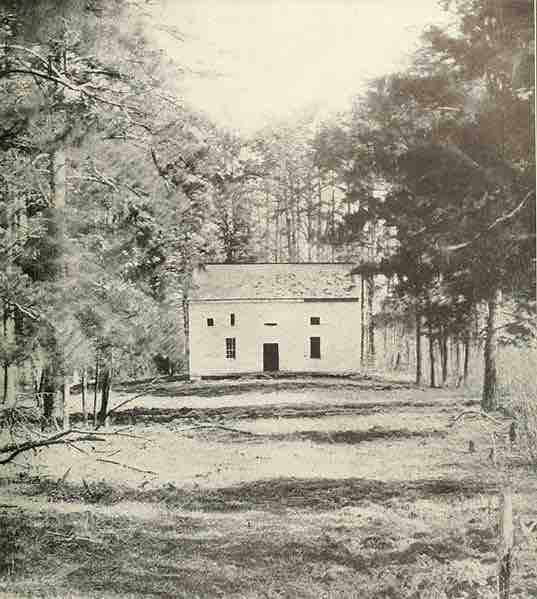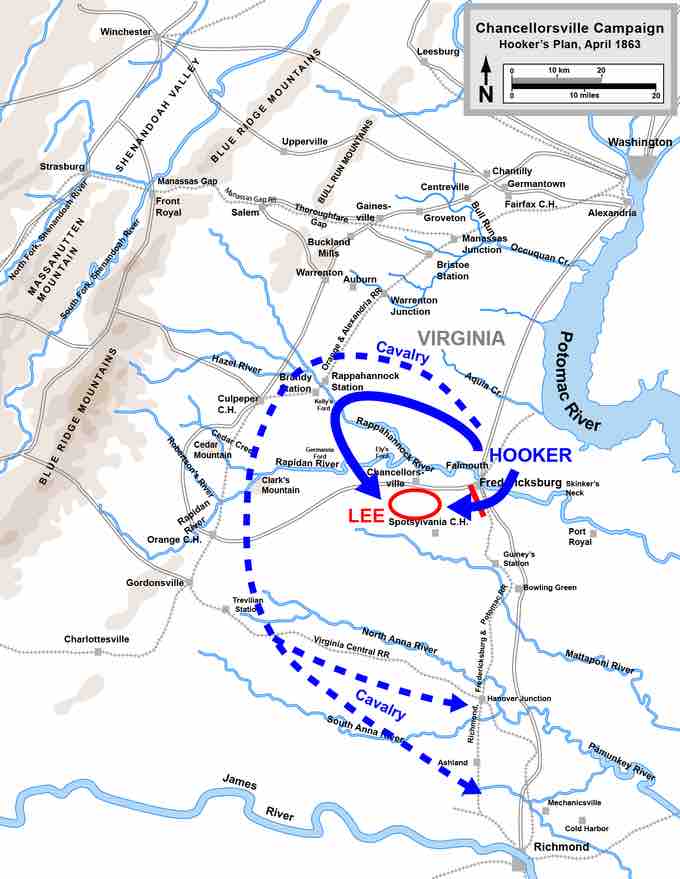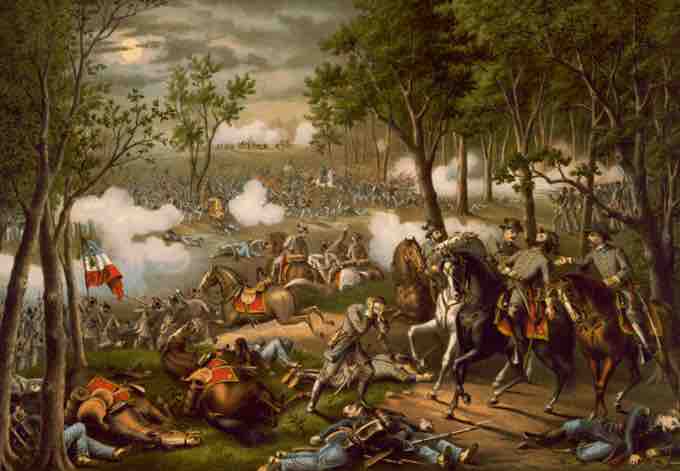The Battle of Chancellorsville was a major battle of the American Civil War, and the principal engagement of the Chancellorsville Campaign. It was fought from April 30 to May 6, 1863, in Spotsylvania County, Virginia, near the village of Chancellorsville. Two related battles were fought nearby on May 3 in the vicinity of Fredericksburg. The campaign pitted Union Army Major General Joseph Hooker's Army of the Potomac against General Robert E. Lee's Confederate Army of Northern Virginia. Chancellorsville is known as Lee's "perfect battle" due to his risky decision to divide his army in the presence of a much larger enemy force, which resulted in a significant Confederate victory. The victory was tempered by heavy casualties and the mortal wounding of Lieutenant General Thomas J. "Stonewall" Jackson by friendly fire, a devastation that Lee likened to, "losing [his] right arm."
The central Union strategy in the eastern theater was to seize the Confederate capital, Richmond. Four attempts in the first two years of the war had been thwarted. After this string of defeats, President Abraham Lincoln became convinced that the Union’s real strategy should lie with defeating General Robert E. Lee’s forces rather than capturing the Confederate capital. Nonetheless, the best strategy for doing this involved advancing toward Richmond. Lincoln placed Major General Hooker in charge of the offensive, and Hooker developed a strategy that was, on paper, superior to those of his predecessors.

Wilderness Church at Chancellorsville
Wilderness Church at Chancellorsville was the center of a stand made by Union General Schurz's division after Confederates under Stonewall Jackson made a surprise flank attack. The stand was brief, as the Confederates smashed through and continued to roll up the Eleventh Corps (under the command of General Oliver O. Howard).
The Chancellorsville Campaign began with the crossing of the Rappahannock River by the Union Army on the morning of April 27, 1863. Union cavalry under Major General George Stoneman began a long distance raid against Lee's supply lines at about the same time. This operation was completely ineffectual. The federal infantry concentrated near Chancellorsville on April 30. Combined with the Union force facing Fredericksburg, Hooker planned a double envelopment , attacking Lee from both his front and rear.

Hooker's plan for the Chancellorsville Campaign
One of a series of maps of the Battle of Chancellorsville of the American Civil War. This one depicts the plan of Maj. Gen. Joseph Hooker prior to the campaign.
The fiercest fighting of the battle—and the second bloodiest day of the Civil War—occurred on May 3 as Lee launched multiple attacks against the Union position at Chancellorsville, resulting in heavy losses on both sides. The campaign ended on May 7 when Stoneman's cavalry reached Union lines east of Richmond. The Chancellorsville Campaign was one of the most lopsided clashes of the war, with the Union's effective fighting force more than twice the Confederates', the greatest imbalance during the war in Virginia.
In his Fredericksburg headquarters, Lee was initially in the dark about the Union intentions. As intelligence information about the Union's river crossings began to arrive, Lee did not react as Hooker had anticipated. He decided to violate one of the generally accepted principles of war and divided his force in the face of a superior enemy, hoping that aggressive action would allow him to attack and defeat a portion of Hooker's army before it fully could be concentrated against him.
Despite his being in a potentially favorable situation, Hooker halted his brief offensive. His actions may have demonstrated his lack of confidence in handling the complex actions of such a large organization for the first time, but he also had decided before beginning the campaign that he would fight the battle defensively, forcing Lee, with his small army, to attack Hooker's larger one. Hooker's decision to change plans led to disagreements and misunderstandings with his subordinates.
Lee, despite being outnumbered by a ratio of over two to one, won arguably his greatest victory of the war, sometimes described as his "perfect battle." However, he paid a terrible price for it. With only 60,000 men engaged, he suffered 13,303 casualties, losing some 22 percent of his force in the campaign—men that the Confederacy, with its limited manpower, could not replace. Just as seriously, he lost his most aggressive field commander, Stonewall Jackson. Of the 133,000 Union men engaged, 17,197 were casualties, a percentage much lower than Lee's. Lee's Chancellorsville battle consisted of a pastiche of unbelievably risky gambits that led to a great triumph. Hooker's campaign, after the brilliant opening movements, degenerated into a tale of missed opportunities and underutilized troops.

Battle of Chancellorsville by Kurz and Allison
Battle of Chancellorsville by Kurz and Allison depicts the wounding of Confederate Lt. Gen. Stonewall Jackson on May 2, 1863.